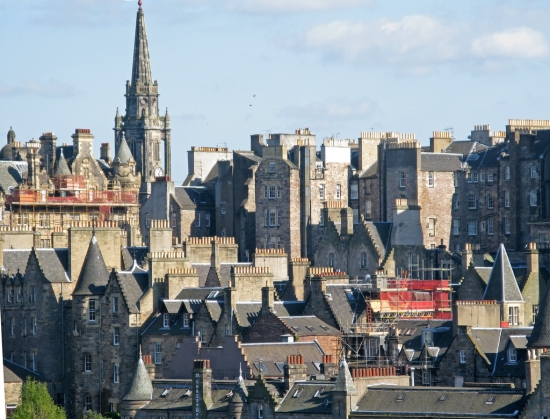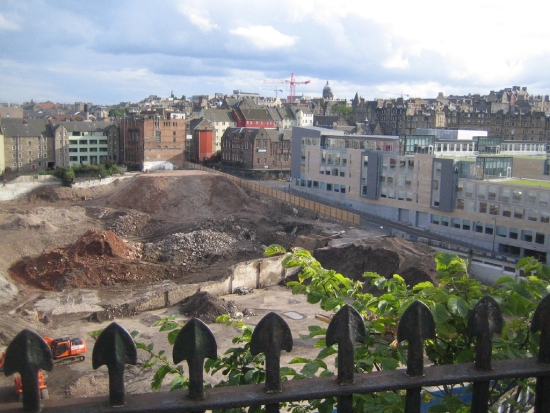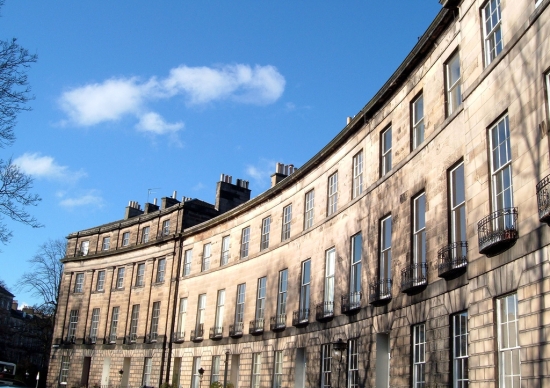Thirteen years after it was originally submitted Edinburgh planners have approved a reworked application to redevelop the city’s Caltongate area. The controversial £150m scheme, like its old town site, has survived a troubled history.

The original Caltongate redevelopment project was first unveiled in 2001 and granted planning consent the following year. Three years later the site was sold to London-based developer Mountgrange Capital which submitted an enlarged plan for the site. That was approved in 2008.
Within 12 months Mountgrange Capital collapsed, leaving the Caltongate land in the hands of administrator Deloitte. It eventually sold the site in late 2011 to its present owners Artisan Real Estate Investors which, late last year, submitted updated plans that have now been approved.
Under the latest scheme — which includes protecting the listed Canongate Venture building and the façade of the Old Sailor’s Ark — South African-based Artisan wants to build 220,000sq ft of offices, alongside retail, hotel and leisure properties. All will open onto a £6.5 million civic square.
Other changes to the 2008 planning application include preserving the historic views of Calton Hill from the Royal Mile by reducing the height of some of the proposed buildings.
“This has been an exceptional planning approval for an exceptional development. This is one of the most challenging city centre developments anywhere in the UK, and we now have the opportunity to create, in the very heart of Edinburgh, one of Europe’s most exciting and vibrant mixed-use communities which will set an international benchmark for sensitive and innovative development,” said Artisan’s managing director, Lukas Nakos.

The five-acre city centre site, borders the Scottish capital’s New Street and East Market Street areas on one side and Waverley Station with the historic Royal Mile on the other. Nakos claims the development will create 700 construction jobs and more than 1,000 when completed.
Ian Perry is Edinburgh City Council’s planning committee convener. Commenting on the latest approval, he said: “Following an 18-month consultation period on the current plans, it is great news that we finally have a decision on a development which I believe will breathe new life into a long standing vacant site in the heart of the city.”
Artisan’s scheme, like its predecessors, has attracted fierce criticism, mainly for the impact its modern buildings will have on Edinburgh’s status as a UNESCO World Heritage Site.
Scottish novelist, Candia McWilliam, has described the latest vision for Caltongate as “torpid and tactless”. While best-selling author Alexander McCall Smith said: “The Old Town is one of the great glories of Scotland, indeed of Europe. How can we destroy the very thing that brings people from all over the world to Edinburgh by allowing inappropriate and ugly developments when there are plenty of constructive ways of regenerating old areas?”
Meanwhile it has been revealed that Scotland’s capital is second only to London when it comes to the creation of new jobs within the UK.

A two-year study by the Centre for Cities think tank — established by the Labour peer, Lord Sainsbury — examined 63 of Britain’s cities and found that, during the course of the survey, 23,100 jobs were created by Edinburgh-based businesses offsetting the 3,300 public sector jobs lost by the cash-starved city council and other bodies.
Not surprisingly, London accounted for 79 per cent of all UK private sector employment growth between 2010 and 2012, with 216,000 private sector jobs created within the capital. Public sector employers took on 66,300 new workers during the same period.
London does not escape criticism, however. The Centre for Cities report claims it is still viewed by many as the place to go to build a career and is acting a talent drain on the rest of the country. Almost a third of people aged between 22 and 30 who moved from their home cities to find employment headed for London.
The non-partisan report placed several northern cities — Manchester, Liverpool, Leeds, Newcastle and Sheffield — in the top 10 for private sector jobs available in 2012. But in terms of actual growth, southern cities such as Aldershot, Peterborough, and Cambridge once again come out on top. Stoke, in tenth place, is the furthest north of the top 10 cities to have seen a growth in private sector positions.
Back in Scotland, Aberdeen came second only to London in terms of the number of business start-ups, returning 27.1 per 10,000 of population. Entrepreneurial ventures in London were recorded at an all-time high of just over 57 per cent per 10,000 residents. But while Aberdeen was ranked in the top 10 for private sector job creation, it lost 4,900 public sector jobs during the same period.
Aberdeen was also ranked fifth on overall employment with a rate of 75.5 per cent in the year June 2012 to June 2013.
In contrast, Scotland’s second city Glasgow ranked 55 of the 63 locations with an employment rate of 64.8 per cent. It also scored disastrously for job creation, coming in second to last behind bottom placed Bristol, and showing an overall loss of 7,800 private sector jobs and 6,800 public sector jobs during the course of the survey.
There were also some confusing results when it came to the so-called happiness scale. Of the eight English cities in the bottom ten for “life satisfaction”, five —Blackburn, Barnsley, Burnley, Rochdale and Mansfield— are in the north. However, Hastings on the south coast was ranked the very lowest.
Previous Post
Blackstone joins the shift to German Commercial Property